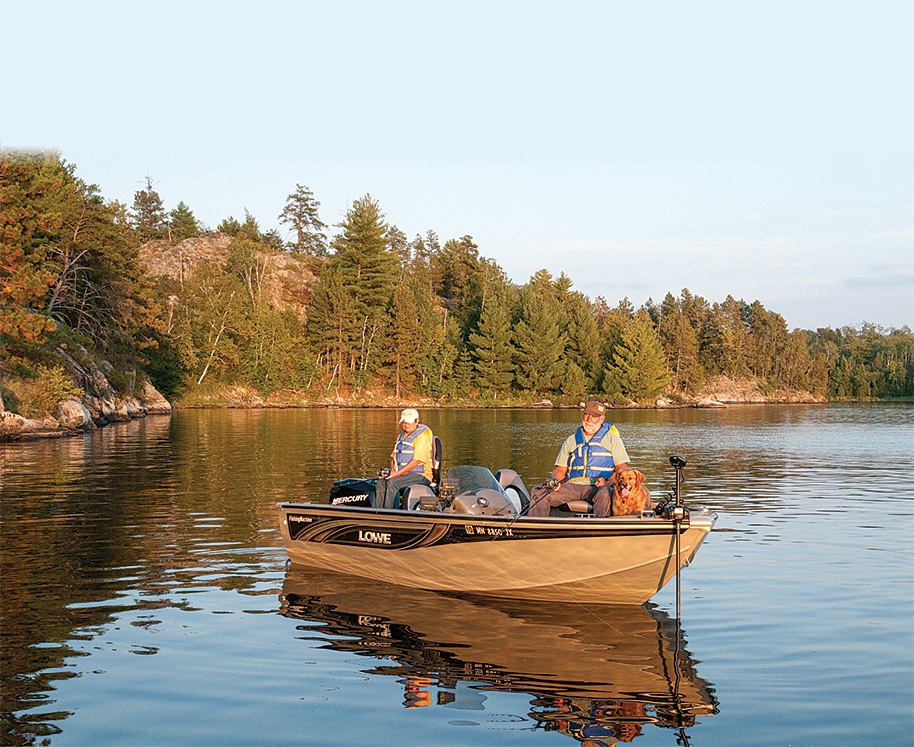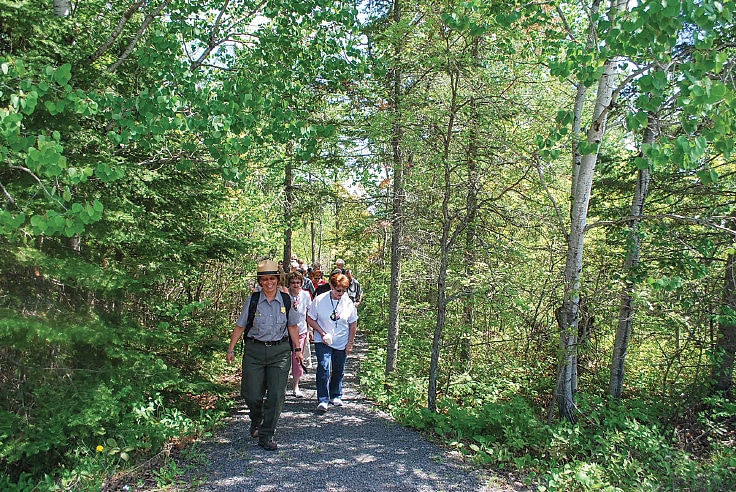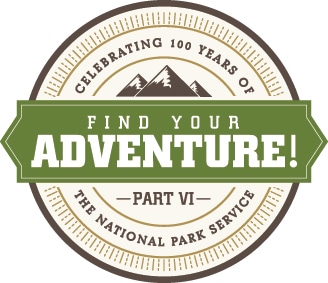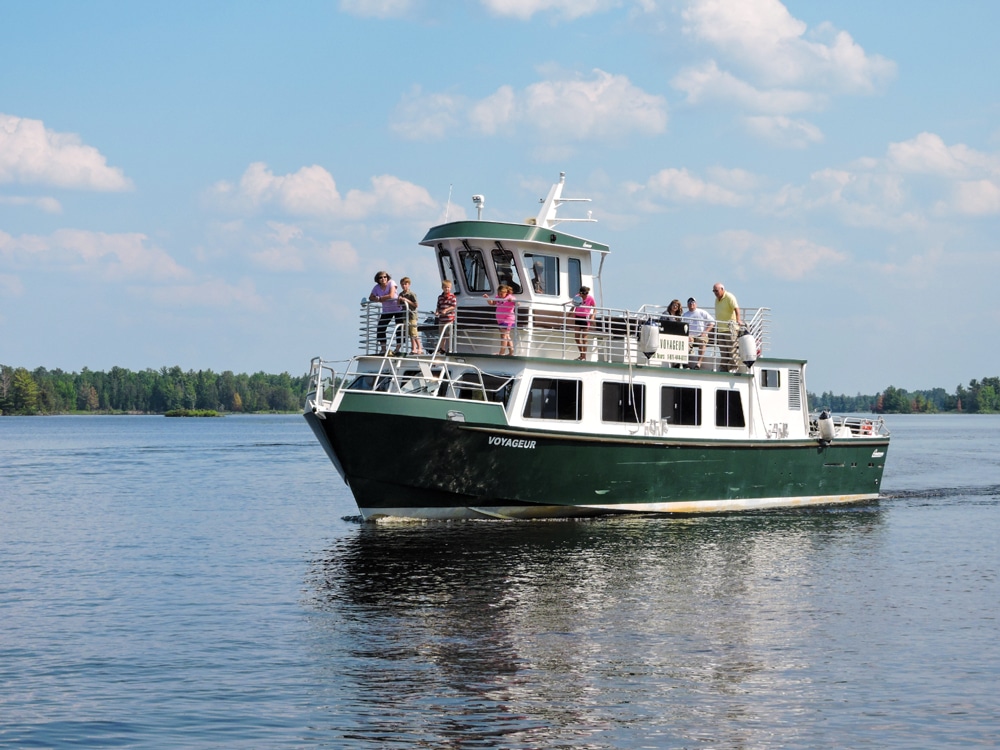Set sail for adventure at Minnesota’s Voyageurs National Park
As you dip your paddle blade into the clear water of Rainy Lake, the present day seems to fall away as you find yourself paddling a birch-bark canoe loaded down with  90-pound bundles of beaver pelts headed for the fashionable hat factories of 18th-century London or Paris.
90-pound bundles of beaver pelts headed for the fashionable hat factories of 18th-century London or Paris.
In Voyageurs National Park that unexpected sensation of time travel is not as uncommon as you might think. It may be because the French word voyageur, which translates roughly to “traveler,” has more than one meaning. Or it may have something to do with the park’s spectacular scenery that in many places looks virtually unchanged from the days of the original voyageurs.
One thing is for certain, though. Namely that this region of lakes and islands remains as welcoming to visitors with an adventurous spirit as it was 200 years ago when the fur trade first opened this area to outsiders.
Lay of the Land
|
Straddling 55 miles of the United States-Canada border, one of the best parts about this watery paradise near International Falls, Minnesota, is that it’s an easy five-hour drive from the Twin Cities of Minneapolis and St. Paul.
Unlike many national parks, however, visiting Voyageurs is not a drive-through experience. That’s because more than one-third of its 218,000 acres are covered in water and much of the rest is only accessible by boat, a fact that makes visiting this national park a decidedly uncommon adventure.
Voyageurs National Park is made up of four main lakes: Rainy, Kabetogama, Namakan and Crane. There are more than two dozen smaller ones in total, along with some 900 rocky islands just waiting to be explored.
On those explorations, don’t be surprised if you catch sight of bald eagles in the treetops or a bull moose wading through the shallows. The call of the loon seems to be everywhere, but if you hear another unfamiliar keening it might very well be the howls of the park’s reclusive timber wolves.
The 344 square miles of Voyageurs National Park also hold another hidden secret. Because of its location on the edge of the geological core of the North American continent, this is one of the few places on the planet that you can see and even walk on rocks that are half the age of the Earth itself.
The First Voyageurs
Established in 1975, Voyageurs National Park preserves part of the 3,000-mile route the French-Canadian and English fur traders used to explore the northwestern frontier in the late 17th and early 18th centuries.
The first voyageurs, more accurately known as courers des bois, worked alone and did much to establish paths through this watery landscape for those who would follow. This also made them the first Europeans to interface with the Native Americans in this part of the country, as the Ojibwa people trapped the animals and prepared the pelts that they then traded for modern luxuries such as blankets and metal knives.
Later, after the French monarch required fur traders to have a license, the men who actually became known as voyageurs worked as employees of license holders like the Hudson’s Bay Company. Based in Montreal, Canada, the voyageurs would take trade goods west each spring and return with pelts in the fall.

Look up to the tops of tall trees along the lakeshore to spot a bald eagle, a year-round resident of the park.
These were no easy jobs back in the day either. In addition to paddling their huge eight-man birch-bark canoes for up to 16 hours a day, they also had to carry both the canoe and 90-pound bundles of furs over the portages between lakes. By the early 1800s there were as many as 3,000 men earning their living as voyageurs, before fur fell out of fashion around 1840.
The route the voyageurs took in their travels ultimately became so important that it served as the basis for the border between the United States and Canada. The 1783 treaty that ended the American Revolution set the international boundary as the “customary waterway” used by the voyageurs.
Can You Canoe?
To get a feel for the life and times of the actual voyageurs, stop by any of the three national park visitor centers and hop aboard a 26-foot North Canoe.
But be aware this is no pleasure cruise. Propulsion is provided by you and a group of your nouveau-voyageur pals as you paddle your way past incredible views of broad marshes and rocky, pine-crested islands.
Under the watchful eye of two park service interpreters in period dress, this 90-minute paddle trip will take you back two centuries as you get a taste of what it’s like to crew one of these giant freighters of the canoe world. In addition to perfecting your paddling strokes, you’ll learn the voyageurs salute and some of the songs the men sang to help them keep their spirits and bodies from flagging during the arduous journey.
Floating, an Idea
If you’d prefer rowing your own boat, you’ll find canoes and kayaks available for rent from local resorts and outfitters. If you’d rather not go it alone, you can find outfitters that also offer guided paddling trips from daylong excursions to multiday adventures.
If you’d prefer a motor assist, many of the same operators rent powerboats as well. Choices range from small skiffs with outboard motors to pontoon boats big enough for the whole family. While there’s a lot to be said for the Zen-like peacefulness of paddle power, even a small outboard motor can make a big difference in the amount of ground, er, water you can cover in a single day.

If you’d like to spend the night on the lake, there are also several places that rent houseboats. Sizes run the gamut from modest floating condos all the way up to luxury barges complete with hot tubs and waterslides.
Whatever form of watercraft you end up engaging, take the time to familiarize yourself with its operation before you cast off. Even more important, take the time to learn the rules of the road, such as what to do when you encounter the red and green buoys that mark most major channels.
You’ll also want to get the lay of the land, er, lake before setting out. Because of the sheer volume of islands and bays in the park, things can get a little confusing, so make sure you have a map of the lake and know how to read it.
Last, but certainly not least, go slow. While the marked channels should present no problem, these lakes are known for having rocks just beneath the surface – very few of which are marked – ready and waiting to turn your pleasure cruise into a rerun of “Gilligan’s Island.”
On the Border
If you don’t feel up to paddling or piloting your own craft, there are still ways to get out onto the water.

Forty percent of the park are the waters of Rainy, Kabetogama (shown), Namakan and Sand Point lakes.
Among the most reliable are the boat tours offered by the National Park Service itself. There are a half-dozen different tours in all, ranging from shorter 90-minute cruises to excursions that last the better part of the day, including a lunch stop.
Boat tours leave from both the Rainy Lake and Kabetogama Lake visitor centers. Trip options include an outing to Little American Island, where you can see the remnants of the Bushyhead Mine and learn about the brief but intense 1890 Rainy Lake gold rush. Another tour circumnavigates Rainy Lake in search of wildlife, including bald eagles.
The longest tour takes visitors to the Kettle Falls Hotel, located a short stroll from the Canadian border. There you’ll have the chance to explore and grab a bite to eat at the historic 1910 Kettle Falls Hotel and visit the nearby dam that’s one of the few places you can stand on U.S. soil and look south into Canada.
Wetting a Hook
With all this water comes, that’s right, you guessed it, a lot of fish. Making Voyageurs National Park a little slice of heaven on earth for folks who live for wetting a hook.
Park officials say there are more than 50 species of fish lurking under the waves, including lake sturgeon, northern pike, black crappie and smallmouth bass. The area is also considered by many to be the best walleye fishery in the country.
The Voyageur Spirit
No matter how you spend your time here, you’ll come away with an understanding of how those original voyageurs were eager to meet the untamed wilderness on its own terms. More importantly, you’ll find that same spirit of adventure still lives on in Voyageurs National Park.
If You Go
Here’s what you need to know to make the most of your visit to Voyageurs National Park:
Visitor Centers
The national park has three widely spaced visitor centers. They include, from west to east, the Rainy Lake Visitor Center, the Kabetogama Lake Visitor Center and the Ash River Visitor Center.
National Park Service Boat Tours
Don’t wait to book your passage as sailings do sell out, particularly in the busy summer season. Reservations:
877-444-6777 | www.recreation.gov
Fishing Guides, Boat Rentals
www.destinationvoyageursnationalpark.com/guides-and-charters
www.kabetogama.com/outfitters.htm
www.rainylake.org/things/guides-outfitters
Fishing License
A Minnesota fishing license is required. You can get one online at www.licenses.dnr.state.mn.us or by calling 888-665-4236.
Guided Kayak Trips
218-244-6506 | www.voyageursoutfitters.com

Oberholtzer Trail (above, right) is an easy, 1.7-mile hike through the forest near Rainy Lake Visitor Center.
Campgrounds
Arnold’s Campground & RV Park
218-285-9100 | www.arnoldsfishing.com/camping.htm
Pines of Kabetogama
218-875-2000 | www.thepineskab.com
Woodenfrog State Forest Campground
218-235-2520 | www.dnr.state.mn.us/state_forests/facilities/cmp00032/index.html




